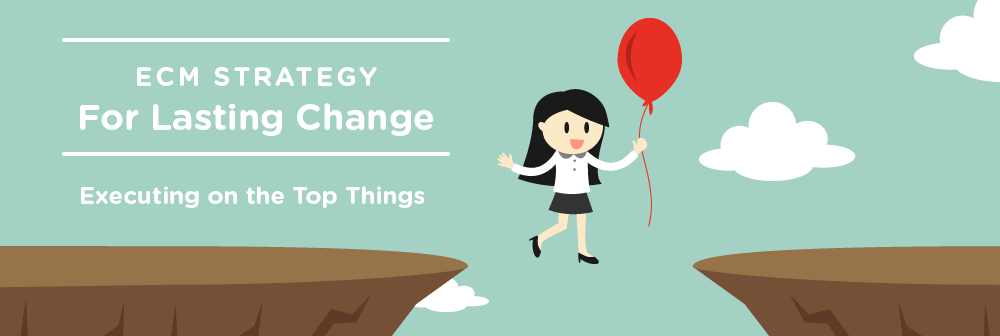Oh my gosh, this seems hard…executing on the top things.
This is the second article in a five-part series on technology strategy techniques that bring about lasting change. In case you missed it, read the previous posts here.
As you begin executing an ECM project, there are going to be hiccups and all out fires. Risks turn into issues, requiring mitigations, new decisions, and so on and so forth. You may start thinking, “What happened to our strategy?!” One of the most important things you need to do, in times of project stress, is remind your team to apply basics of your strategy throughout all phases of execution of the project. It’s very easy to be distracted or get off track due to delays, scope creep, and unexpected issues. However, what’s important is not what comes up (because things will come up!) but how you get through it. Remember all the work your team did in the previous stages—that success criteria and planning? Use it! Apply it! In every situation, weigh the next steps against the strategy that you originally set out for your success.
Validate your readiness to execute
Before you roll into implementation, stick to the framework to execute on project excellence. Are you prepared? If so, you have answers to all the key items from my last post—Why, Who, and How. A checklist for readiness looks like this:
- Success criteria is agreed upon with stakeholders before the start of the project.
- Collaborative working relationships are on the way to being established for all the assigned resources. The project owner (or sponsor) and the project manager are in sync and guiding the team.
- The project is set into motion with an overarching review of the initial design and resulting plan with architects, IT support, and other key services teams and stakeholders (as needed). Discussions and whiteboarding sessions are held to build a set of designs for the project’s phases. The outcome of this work includes the following types of items:
- Design diagrams and documents
- Solution infrastructure and scaling recommendations
- Big picture view of project milestones
- A backlog of user stories for the high-priority implementation items
- Work breakdown of the first few sprints of work
- Communication plan and meeting cadence determined
- A list of out-of-scope areas for further discovery to be discussed in later phases
Strategy Desk Tip:
It’s critical to have a clear set of success criteria identified. However, do you know how you are performing against that criteria today? Set a baseline for the current system performance to ensure you can measure progress. The baseline could also point out gaps on how you will quantify your success criteria overall. You may find early on that you do not have a way to measure your end goal. Better to know this and account for it sooner rather than later!
A methodology for implementation
Once you’ve checked off the readiness items, adopt a methodology for making progress on your milestones. Each project and each team is different so there isn’t a single, foolproof methodology that works for everyone. The most important thing is to adopt one that works for your team’s style, get really good at it, and set a regular cadence for the project. A useful methodology includes these few key things:
- Iterative development cycles to ensure traction and momentum.
- Focus on scope management. The team identifies creep, weighs options against anything that threatens scope, and adjusts deliverables as required.
- A clear set of guardrails for keeping the project on track such as regularly scheduled meetings (daily standup, weekly project status, monthly executive review).
- Paths out of pitfalls including a project manager who is empowered with flexibility to deal with unforeseen circumstances and dedicated decision-makers who understand the plan and project success criteria when called upon.
- Time for developers to execute but also participate in iteratively planning the next set of work breakdowns for upcoming sprints.
- Time for QA resources to unit test and provide quick feedback while also developing end-to-end tests.
- Regular communication with, and involvement of, key stakeholders.
The Zia methodology has been fine-tuned over the last 10 years to deliver industry-leading solutions. During the heavy lifting of implementation phases, we plan and run development sprints, each for a set period of time, during which specific work is to be completed and made ready for review and initial testing. The project owner and the development team agree upon the exact work to be accomplished during the sprint. The sprints are tied to a higher-level set of milestones to ensure cadence and velocity meets goals and expectations. Each sprint is completed in a specific set time (generally one to three weeks) with the following type of deliverables:
- Business analysis documentation, feeding sprint planning, and development
- Estimates and work breakdowns of user stories for each sprint
- Delivery of working code
- Sprint demo to core team and key stakeholders
- Technical walk-through and code reviews (where applicable across development resources)
- Testing hand-off instructions and test script development
- Assistance and education of stakeholders through simple cases for sprint acceptance testing
- Strategy check! Are we building to the plan or getting off track? How are we doing against the larger milestones?
- Beginning and continuing work on overarching project communication and developing a change management strategy
- Rinse and repeat for each sprint cycle
Strategy Desk Tip:
During planning and design, you found out what motivates and provokes your stakeholders. As sprint demos start, you may need to reset stakeholder’s understanding of the success criteria. Make sure each sprint demo is carefully planned to show how it supports the objectives originally agreed upon. Stakeholder feedback should always be listened to and responded to promptly but also measured against the degree to which each stakeholder can influence the project. Regular discussions are appreciated and could soften the blow when you need to push back on scope creep and change requests.
Once the development cycles of each phase of the project are complete, time should be allocated for hardening and rollout. This step includes final UAT, bug fixing, and tuning. Typical deliverables are:
- Hardened code and infrastructure for entire phase
- Resolving priority 1 and 2 defects
- Delivering subject matter expert training to prepare for final-user acceptance testing and user training
- Performance benchmarking and tuning
- Document phase solution architecture, key configurations, and customizations
- Cutover, rollout, and go-live planning
Strategy Desk Tip: All-Ways Communication
No matter how well thought out the methodology, one of the most important parts of execution is an emphasis on great communication. Many times, individuals are highly accountable for their tasks—and great at executing—but fall short at actually talking to one another. Teams that break down reporting structures and thrive on openness and collaboration continually foster cross-team communication once the execution of the project begins. This means talking to one another, sharing and showing each other’s work, and having discussions up, down, and across reporting chains. This is what I call all-ways communication—communicating in all directions, all of the time!
Key Takeaways:
Check your readiness to execute: Ensure that you can check off all the key items from your planning stage. Projects that execute well refer back to the basics when bumps in the road come along.
Follow a methodology: Research and adopt a methodology that works for your team. Some organizations have cultures where pure agile won’t work. In other cases, teams can be bored and frustrated with lack of progress while in waterfall timelines. Adapt a pure methodology or a hybrid one, but be consistent and communicate!
Communicate, communicate, communicate: It may be painful at first for some team members, but fostering communication is arguably as important as doing the work breakdown. Remote teams need this even more and there are lots of tools you can use to help.
Next time we’ll discuss numbers…yes, it’s time to start measuring your success.





